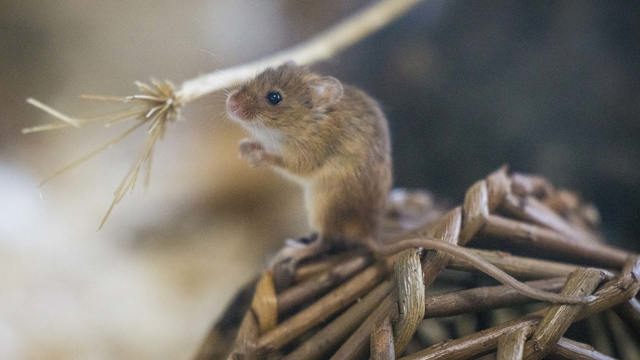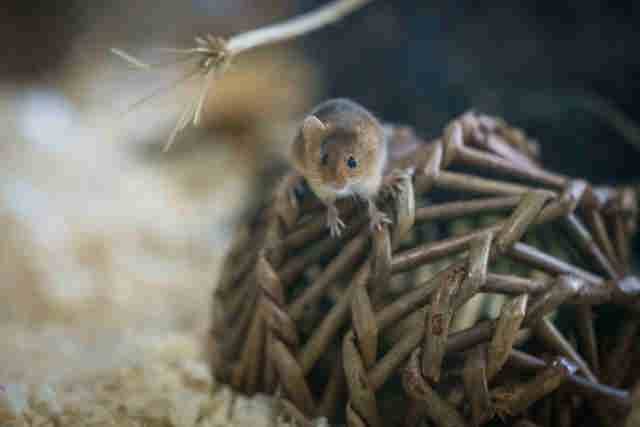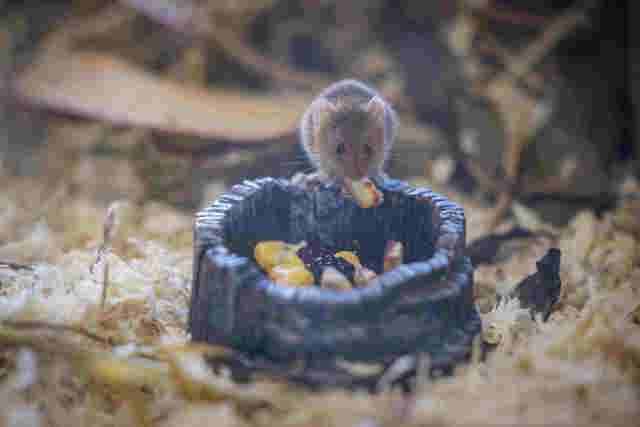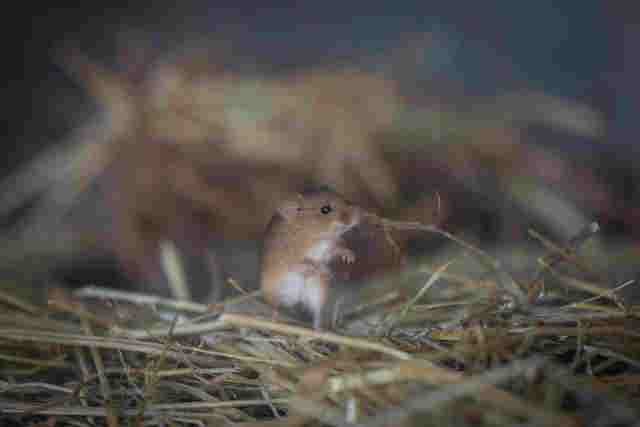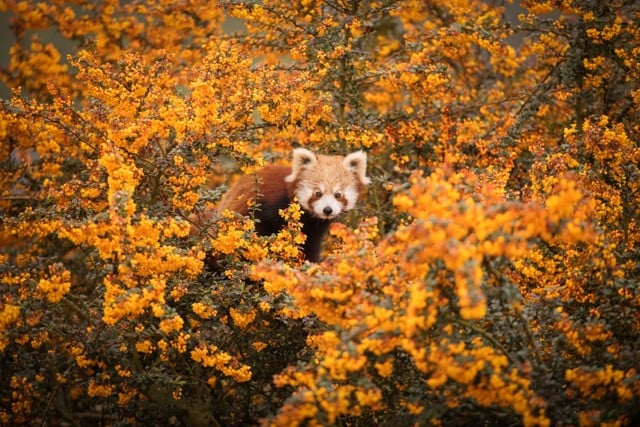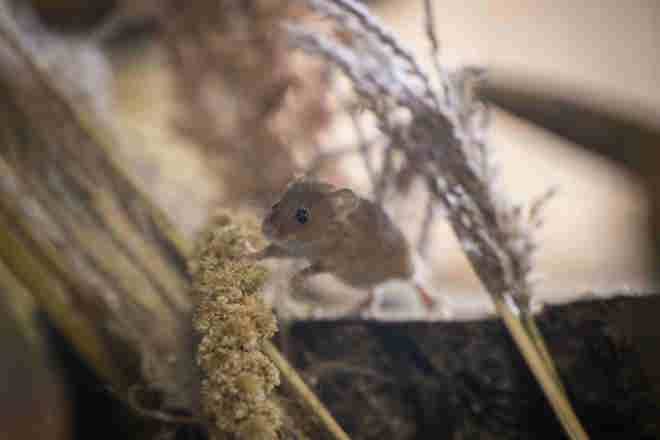
Overview
Harvest mice are tiny native creatures, primarily found from central Yorkshire down to the coast of southern England. They are an iconic feature of the British countryside because of their love of long tussocky grasslands, hedgerows and farmland, but they can also be spotted in reedbeds and around woodland edges. They are the only British mammal to have a prehensile tail, making them incredibly acrobatic.
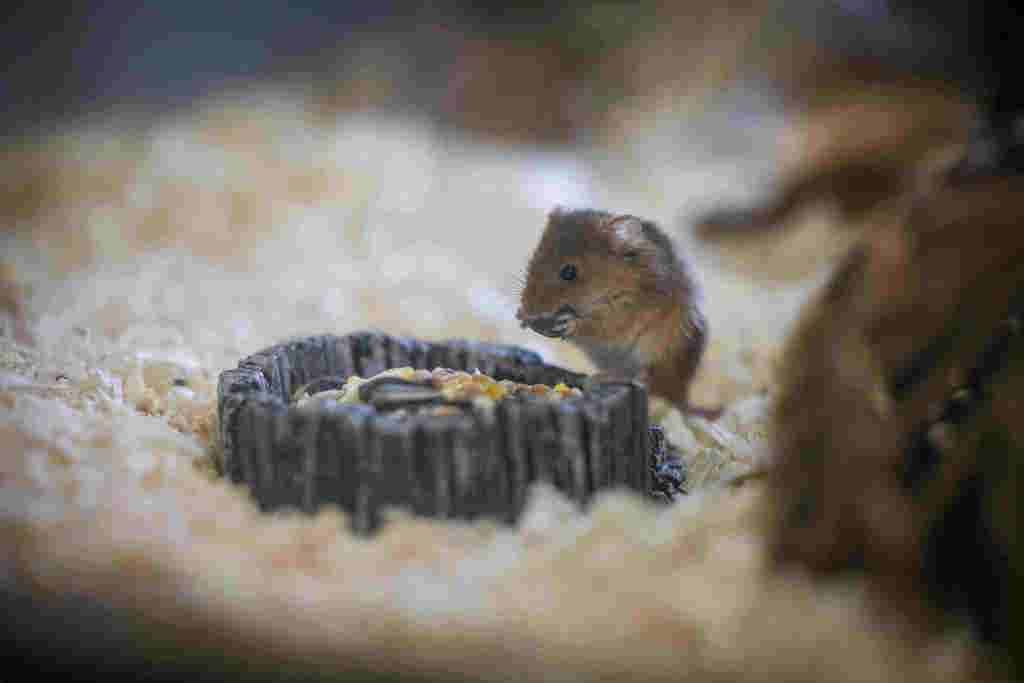
All about us
| Distribution: | Much of Europe, parts of Asia including China, Japan and India |
|---|---|
| Habitat: | Long tussocky grassland, reedbeds, hedgerows, farmland and woodland edges |
| Height: | 5 to 7cm |
| Weight: | 4 - 6g |
| Lifespan: | 18 months, on average |
| Threats: | Competition and predation, habitat fragmentation and harsh weather conditions |
Scientific name: Micromys minutus
The group of harvest mice here at Woburn live in an enclosure in the Foot Safari, just in front of the Cachorro Range habitat.
They can often be seen scurrying back and forth amongst the leaves and tall grasses that mimic the features of their natural rural habitat. They also love to explore using their long prehensile tail to help them climb and maintain their balance whilst running and jumping around the various logs and ropes.

harvest mice facts
- Physical features
- Diet
- Social structure & communication
- Husbandry and enrichment
- Threats & conservation
Very small in size, the average adult only weighs between 4-6g and measures just 5-7cm long including their tail. They have an orange/brown coloured fur that covers their face, body and outer ear, and a pale or white fur that runs from their chin down their belly, covering their underside. The head features a blunt nose and small eyes, as well as those rounded hairy ears.
Because of their small stature they have developed an acute sense of hearing to help avoid predation, and will either freeze or drop into cover in response to rustling sounds up to 7m away. They are also active and agile climbers, and have a long prehensile tail and broad feet that have adapted to help with balance when jumping and moving around at height. It also acts almost like an extra hand to help them grasp and hold on whilst climbing or eating in the stalk zone of long grasses and reeds. Their tail grows to the same length as their body, and is almost hairless.
Because of the similarity in colour they are often confused with the hazel dormouse, but the dormouse is much larger in size, has much bigger eyes and a furrier tail than the tiny harvest mouse.
The harvest mouse’s diet consists mainly of seeds, berries and insects, but they will also occasionally feed on fungi, moss, roots and some herbage. Like many rodents they have a very high metabolism, so need to take on a lot of food and water to meet high energy demands.
When feeding on cereal crops the harvest mouse nibbles grain from the cereal head, which leaves the characteristic sickle-shaped remains, however there is usually no notable damage to the cereal crop itself.
Harvest mice are not naturally a social species, but can live in colonies if they have been introduced at a young age.
Although slow and hesitant in their movements, Harvest mice have periods of high activity usually lasting a couple of hours, where they bound across open ground and use their hind legs to leap and climb whilst exploring their surroundings. This is often followed by a similar length period of low activity and rest. When a group is living in close proximity like the nest at Woburn, these periods synchronise and repeat throughout the day and night.
Harvest mice are not particularly territorial creatures, but some evidence suggests that during breeding season females can develop these tendencies as breeding nests tend to be regularly spaced out. Verbal communication and non-verbal aggression also peak during mating season, where courtship consists of a brief chase and – if the doe (female) is receptive – the buck (male) will make excited chattering calls before mating occurs at ground level. If the doe is not receptive then his advances will be cut short by her showing aggression and making clicking sounds. Females have also been known to relentlessly chase males during the breeding season and bite at their tails.
Young harvest mice are born blind and hairless, and start to explore outside of the nest by day 11. By day 16 they are full independent and breeding can start from as early as six weeks, but more likely from around 10 weeks old.
When confrontation occurs outside of mating the mice first conduct a nose-to-nose assessment of their opponent, before a brief chase and attempts to bite at the rump, tail and ears of the more timid animal.
This species is crepuscular, meaning they are mostly active at dawn and dusk.
In the wild, harvest mice would be foraging for food in hedgerows, rummaging in leaf piles, clambering over tree trunks and leaping through crop fields. So that they can continue to mimic this natural behaviour, their enclosure is designed with multi-level platforms made from wood and cut logs, with tall grass and ropes connecting different areas for them to explore. Agile climbers, the mice use the vertical space in their enclosure as much as the ground space by utilising these features, keeping their minds and energetic bodies active.
To replicate their countryside habitat, the ground level is covered in a natural material substrate and littered with fallen leaves, pine cones and other woodland debris. Some hay also provides valuable chewing and hiding places.
Because of their sensitivity to sound and their natural instinct to take cover if they feel threatened, the mice are also given covered areas within the enclosure with the option to venture in and out as they choose during periods of activity and rest.
The Eurasian harvest mouse is found across much of Europe and also parts of Asia including China, Japan and India. It is a UK BAP (Biodiversity Action Plan) priority species having thought to have undergone rapid decline nationwide.
Although distribution is widespread across England it is incredibly patchy due to fragmentation of populations. In neighbouring Scotland and Wales they are listed as Critically Endangered and Vulnerable respectively - with isolated records from Scotland and Wales likely being the result from the release of captive animals - and they are not found in Northern Ireland or the Republic of Ireland. The Mammal Society IUCN-authorised Red List of British Mammals stating they are Near Threatened in Great Britain as a whole.
Some experts suggest that fragmentation is caused in some areas by changes in agricultural practices and land use, but hard winters and wet weather brought about by the changing climate has also impacted populations in certain geographic regions. They are also under threat from competition and predation from other rodents and mammals, as well as birds of prey – the success of some owl conservation projects is thought to have also depleted harvest mice numbers, with them being the preferred prey of barn owls.
